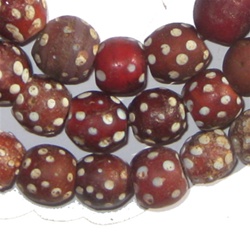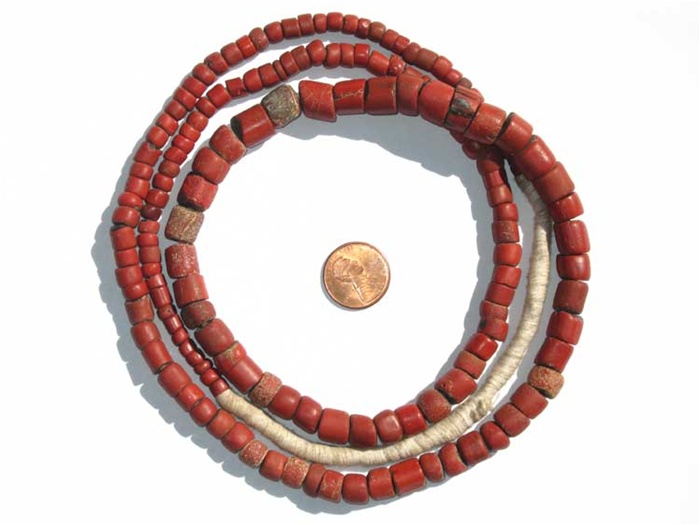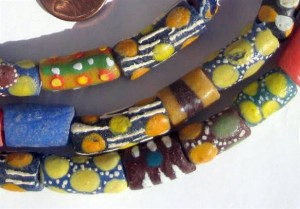King Beads: The Mark of African Royalty
"King Beads", so named because of their popularity among tribal leaders during the trade era, are a type of marvered glass bead made in Murano, Italy, during the 19th Century. The earliest known examples of King Beads date back to the mid 1800s, examples of which can still be seen among the Moses Lewin Levin sample bead card collections held at the British Museum, London.
Characterised by their distinctive bicone shape and bold stripes, King Beads were typically larger than striped Chevrons, and were solely intended for use as a trade currency between merchants and African tribes. But, although Venetian King Beads run the gamut of color variations, the most common are green with yellow, red and black stripes. It is thought that such combinations were produced to enhance the appeal of the beads in Africa. Certain tribes, such as the Krobo of Ghana, are renowned for their use of colored beads as a medium of communication, and consider some combinations to be more desirable than others.
Legend has it that the size and specific colors of King Beads was inherent to their popularity among tribal chiefs in the 19th Century. The Anlo Ewe of Benin and Togo regarded these larger beads as being superior to other types of trade beads, and quickly adopted them as wearable symbols of status. Yellow King Beads became central to the Dipo initiation ceremonies in Krobo culture, since the color is associated with coming of age and future prosperity. Interestingly, a number of archeological excavations in Ghana have revealed that some royals were even buried with their King Beads – possibly to aid their prosperity in the afterlife!
Mythical or Medicinal? The Alleged Properties of Skunk Trade Beads
Skunk Beads, (often referred to as 'Eye Beads' due to the intricacy of some

Antique Skunk Eye Beads, Red.
spot designs) are a product of 18th Century Venetian manufacturing. Created using the wound, or drawn glass production method; Skunk Beads represent one of the earliest forms of 'lampwork', a process which involves the addition of small glass globules to a set surface, giving the 3-D raised effect.
Collectors of Venetian trade beads are often in the dark about why Skunk Beads are so named. It is thought the name actually derives from the similarities of the bead design to the coat of the North and Central American Skunk species 'spilogale'. Unlike the native Striped Skunk, the spotted variety are considerably smaller, often with very intricately detailed coats.
Of the many hues of Skunk Beads that have been produced, purists believe that only the black and white variety are true Skunk Beads. The highly collectible red variant were originally known as 'Cornaline d'Aleppo', so named after the Aleppo Stone ('Eye Stone') thought to originate within Syria.
It is possibly from the mythical properties of the Aleppo Stone, that the powers of Skunk Beads for holistic healing have evolved. The agate Aleppo Stone is alleged to be a cure for a prominent Mediterranean skin disease known as the 'Aleppo Boil' or 'Biskara Boil'. The skin condition usually affects the face, and eventually becomes a pus-filled ulcer if left untreated. Carriage or wearing of the spotted Aleppo Stone is thought to rid carriers of the disease, and act as prevention from it.
So too, Skunk Beads are attributed with similar healing powers, despite being made from glass. This could stem from the beliefs of certain African tribes that spirits are omni-present, particularly within beads that are 'of the Earth'. Glass is typically produced from silica and sand, along with several other natural compounds, therefore glass beads are considered 'of the Earth'. Whether or not Venetian Skunk Beads possess holistic benefits; they are still considered some of the most beautiful and collectible of all African trade beads!
Venetian Trade Beads – Why they are nicknamed ‘talking beads’, by the Ashanti of Africa
Ashante (Asanti), in the heart of Ghana, is a state synonymous with tribal expression and ritual. The Akans (Ashante people) have held precedence as a dominant tribe ever since the 17th Century, when they ruled and controlled most of the 'Gold Coast' (now known administratively as Ghana.) Ghana is also synonymous with the largest level of bead production in Africa, for over 300 years, while the Ashante were the dominating presence, with whom the trade of beads, slaves and goods occurred for over two Centuries.
It is perhaps not surprising then to learn, that the Ashanti, like many Ghanaian tribes, have adopted colored glass trade beads, for the purposes of communication, self-expression, religious ritual and customary rites. The Ashante are of a naturalistic faith, believing that every earthly compound, living thing and substance contains the spirit of ancestors, 'nature Gods' or of the great Ashanti Supreme Being (creator) known as 'Nyame'. To this end, many of the present day rituals, rites and customs are still conducted with the belief that ancestral spirits and 'Gods' communicate through nearly every living thing around them - including beads! Hence, why colours, shapes and even the different pitches of beads as they clack together, hold significance as a 'language' to the Ashanti.
The 'talking beads' of Ashante are worn exactly for the purpose of communication. While the colours are significant, it is the different sounds produced by these beads as they knock against one another when worn, that has borne a unique language among the Ashante, and one that only the trained ear can understand.
Talking beads were traditionally, simple strings of mixed Venetian trade beads - however the modern counterparts tend to be made from recycled glass beads. The beads are predominantly worn by women, and girls from the age of eleven upward, a tradition for which the Krobo women are particularly renowned. Many are of the impression that talking waist beads are used primarily by Ashanti women, to attract the attention of men. This is due to the almost cacophonous noise produced when an Ashanti woman walks with a more pronounced, or even deliberately enhanced feminine gait. The swaying of the hips controls to what extent the beads rattle, therefore can also control how much attention is drawn to this area of the body.
Modern Ashante society has changed a little since the tradition for wearing waist beads first came about. These days, they are considered a very on-trend fashion accessory - yet they are still used by many as a subtle communicational tool, particularly through arts such as dance! Modern Ashante women also appear to be in constant competition with one another, with many using bigger beads for their waist adornments, that will produce far more noise! Perhaps now more than ever before, this is actually to generate increased interest from men, albeit in a manner that is competitive, rather than just a subtle 'notice me' exclamation!
Beautiful Venetian Green Heart Trade Beads
 Today, many bead collectors and artisans enjoy using African white heart beads in their jewelry. White heart beads are more commonly known as Hudson Bay Trade Beads. These glass beads have a colored, translucent outside (usually red, turquoise, green, or yellow), and a white center, hence the name "white heart" beads.
Today, many bead collectors and artisans enjoy using African white heart beads in their jewelry. White heart beads are more commonly known as Hudson Bay Trade Beads. These glass beads have a colored, translucent outside (usually red, turquoise, green, or yellow), and a white center, hence the name "white heart" beads.
People often asked, where did white heart beads come from? Where did they evolve from? The somewhat surprising answer: Venetian green heart trade beads. These venetian beads, shown above, have a beautiful mud-colored outside, and a green center core on the inside. Usually, these beads are old, and were made between the 17th and 19th centuries. The strands typically measure over 30 inches long of trade beads, and run for about $30.
These amazing antique green heart trade beads would make a great addition to your next beading project!
